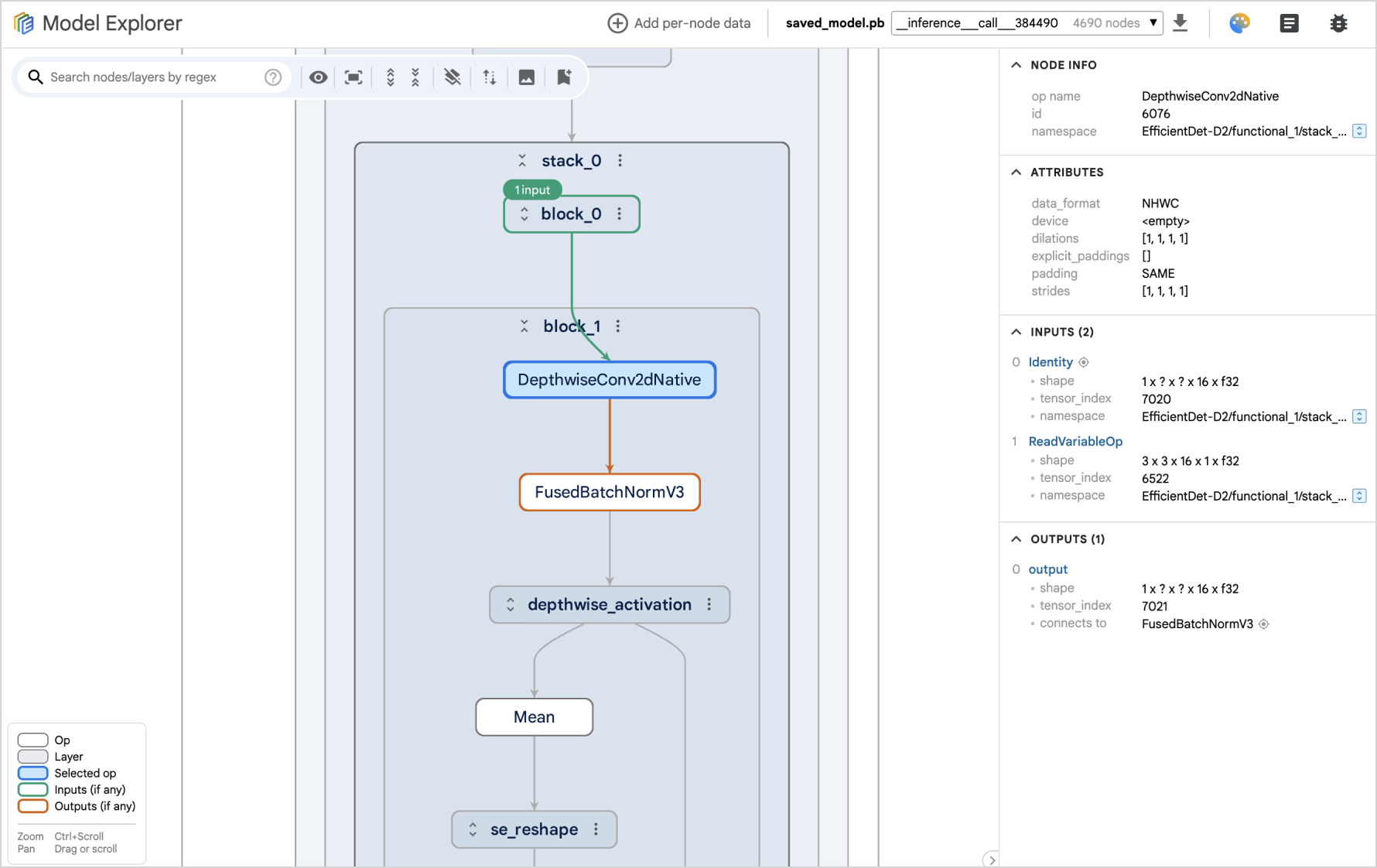This npm package provides the core visualizer UI from Model Explorer as a reusable custom element <model-explorer-visualizer>, enabling easy integration across various UI libraries and frameworks. It offers the following core functionalities:
- Takes a JSON input graph, performs layout calculations in a web worker, and uses WebGL for high performance rendering.
- Allows easy customizations for various UI elements and behaviors, such as hiding certain nodes, setting node styles, restoring UI states, etc.
- Provides APIs to interact with the UI, such as adding custom node data, emit events for various UI actions such as node selected, hovered, etc.
See how it works in our demos, implemented in vanilla JS, vanilla TS, Next.js/React, and Angular.
-
Import the package.
-
Option 1: through the script tag:
<script src="https://unpkg.com/ai-edge-model-explorer-visualizer@latest"></script>
-
Option 2: add dependency in
package.jsonand import it as a module in script:# In package.json { ... dependencies: { "ai-edge-model-explorer-visualizer": "*" } }
import 'ai-edge-model-explorer-visualizer';
-
-
Serve the
worker.jsfile and thestatic_filesdirectory.To ensure the Model Explorer Visualizer functions correctly, you need to serve the
worker.jsfile and thestatic_filesdirectory alongside your main application.Steps:
- Download the package (e.g. from jsdelivr) and extract the
dist/worker.jsfile and thedist/static_filesdirectory and its content. - Place them in the same directory as your
index.htmlfile. Your directory structure should look like the following:
<server_root> - index.html - worker.js - static_files/ - ...Purpose of files
-
worker.js: This file handles computationally intensive tasks, such as layout calculations, within a web worker. -
static_files/: This directory contains essential font textures and styles required for rendering the visualizer correctly.
Customizing file locations (Advanced)
By default, the visualizer expects
worker.jsandstatic_filesto be served from the same location as your application'sindex.htmlfile. If you need to serve these files from different locations, you can configure the following properties in your script:// `modelExplorer` is a global object exported to `window`. // Set base URL for the `static_files` directory. // // Can be a relative or absolute path on your server, or a URL to another server. // If using a different origin, ensure CORS is correctly configured. modelExplorer.assetFilesBaseUrl = 'https://unpkg.com/my-me@latest/dist/static_files'; // Set full path to the `worker.js` file. // // Typically a relative or absolute path on your server. Loading web workers from // different origins is not supported. modelExplorer.workerScriptPath = 'path/to/worker.js';
- Download the package (e.g. from jsdelivr) and extract the
-
Create the custom element and feed it a collection of json graphs to visualize (see demos for examples).
const visualizer = document.createElement('model-explorer-visualizer'); visualizer.graphCollections = [...]; document.body.appendChild(visualizer);
The following properties should be set before adding the visualizer component to DOM.
-
graphCollections:GraphCollection[]An array of graph collections to be visualized. Each collection represents a group of related graphs.
-
config:VisualizerConfigConfiguration object for the visualizer, allowing customization of its behavior and appearance. Refer to the
VisualizerConfiginterface definition for specific configuration options. -
initialUiState:VisualizerUiStateAn object representing the initial UI state to restore when the visualizer is initialized. This can include selected nodes, expanded layers, and other UI-related settings. Refer to the
VisualizerUiStateinterface definition for specific state properties. -
benchmark:booleanEnables a special benchmark mode for performance testing. When set to true, the visualizer ignores all other input properties and allows you to specify the number of nodes and edges to render, along with an FPS counter.
Events are emitted as Custom Events on the visualizer. You can listen to these events using addEventListener and access the event payload (if any) in the detail field.
Example:
visualizer.addEventListener('selectedNodeChanged', (e) => {
const customEvent = e as CustomEvent<NodeInfo>;
console.log(customEvent.detail?.nodeId);
});-
titleClicked:CustomEvent<void>Triggered when the visualizer's title is clicked.
-
uiStateChanged:CustomEvent<VisualizerUiState>Triggered when the visualizer's UI state changes (e.g., selected node, expanded layers). The event payload is a
VisualizerUiStateobject representing the current UI state. This can be used to restore the UI state on initialization using theinitialUiStateinput property above. -
modelGraphProcessed:CustomEvent<ModelGraphProcessedEvent>Triggered when the default graph has been processed.
-
selectedNodeChanged:CustomEvent<NodeInfo>Triggered when the selected node changes.
-
hoveredNodeChanged:CustomEvent<NodeInfo>Triggered when the hovered node changes.
-
doubleClickedNodeChanged:CustomEvent<NodeInfo>Triggered when a node is double-clicked.
-
selectNode(nodeId, graphId, collectionLabel?, paneIndex?)Selects the specified node, expanding all its parent layers.
-
nodeId(string): The ID of the node to select. -
graphId(string): The ID of the graph containing the node. -
collectionLabel(string, optional): The label of the collection containing the node. If omitted, the method searches all collections in the inputgraphCollections. -
paneIndex(number, optional): The index of the pane (0 or 1) in which to select the node. Defaults to 0.
-
-
addNodeDataProviderData(name, data, paneIndex?, clearExisting?)Adds data for node data provider.
This only works after the model graph is processed. Call it when
modelGraphProcessedevent above is emitted.-
name(string): The name of the data to add. -
data(NodeDataProviderGraphData): The data to add. -
paneIndex(number, optional): The index of the pane to add data for. Defaults to 0. -
clearExisting(boolean, optional): Whether to clear existing data before adding new data. Defaults to false.
-
-
addNodeDataProviderDataWithGraphIndex(name, data, paneIndex?, clearExisting?)Adds data to the node data provider, using graph indices.
This only works after the model graph is processed. Call it when
modelGraphProcessedevent above is emitted.-
name(string): The name of the data to add. -
data(NodeDataProviderData): The data to add. -
paneIndex(number, optional): The index of the pane to add data for. Defaults to 0. -
clearExisting(boolean, optional): Whether to clear existing data before adding new data. Defaults to false.
-

